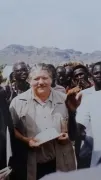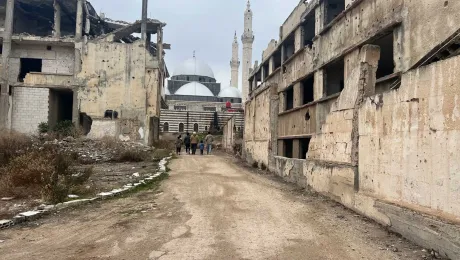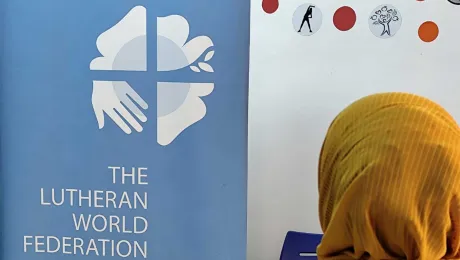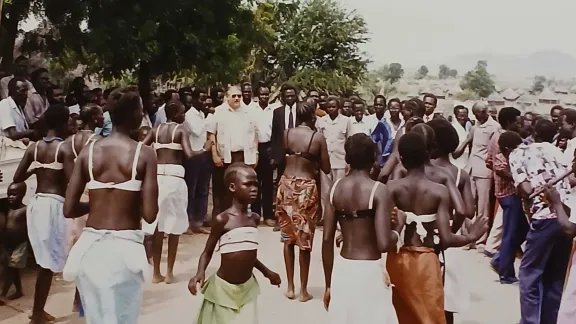
Former LWF Country director Koepp in Kakuma. Photo: Robert Koepp
Former Country Director Koepp shares memories of LWF’s humanitarian work in Kenya
It is heartening to see that LWF World Service has steadfastly supported Kakuma Refugee Camp for so long.
My first experience with the area was in 1973, when I drove an LWF Land Rover with Finn Andersen from Mombasa to Kakuma, a remote village near the South Sudan border. At that time, the border consisted of literally two or three huts and police posts. We picked up the Land Rover at Mombasa Port and proceeded north to Nairobi and eventually to the border town of Kakuma. The world ended there—a rather good dirt road on the Kenyan side but nothing on the Sudanese side. We eventually had to use a compass to navigate to Juba, where the Land Rover was sent by boat on the Nile to the newly opened LWF base.
Welcome to South Sudan!
By 1991, the Second Sudanese Civil War had escalated. Government forces clashed with the Sudan People’s Liberation Army (SPLA). Aid agencies, NGOs, and church groups became active on both sides of the conflict. LWF had established its operations in the southern Sudanese city of Malakal after the 1972 Addis Ababa Agreement.
By the mid-1990s, southern Sudan, and especially the town of Malakal, was probably the worst duty station one could be at, yet LWF remained steadfast. To address growing humanitarian needs, the Sudan Emergency Operation Consortium (SEOC) was founded, bringing together support from LWF, Caritas, and other partners. SEOC became second only to the UN’s Operation Lifeline Sudan, managing massive airlifts to Juba and other locations. I was appointed coordinator during this time.
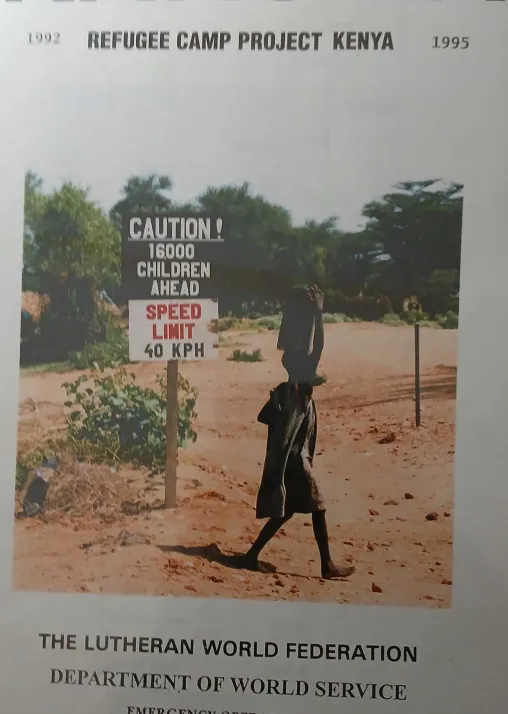
A signpost in Kakuma refugee camp. The Lost Boys formed a large part of it’s initial population. Photo: Robert Koepp
Part of LWF’s operations in Kenya involved setting up a camp for Sudanese refugees who had begun to trickle across the border at Lokichogio. By mid-1992, as insecurity in southern Sudan worsened, about 20,000 refugees crossed the Kenya-Sudan border at Lokichogio, including 16,000 young boys who became known as the Lost Boys of Sudan. These children, some as young as six or seven years old, had been displaced or orphaned during the Second Sudanese Civil War (1983–2005). To escape violence and recruitment by armed groups, they had trekked thousands of kilometers across South Sudan, northern Zaire (now the Democratic Republic of the Congo), and Ethiopia before arriving at the Kenyan border.
The setup of the camp
Eventually, these refugees were relocated to a new camp set up in Kakuma in 1991. At that time, Kakuma was a small trading post of the Turkana, a pastoralist community, with about 8,000 inhabitants. With support from UNHCR and the Kenyan government, LWF took over management of Kakuma Refugee Camp in 1992. The refugees, including the Lost Boys, were transferred from the temporary holding camp in Lokichogio, and arrangements for education, water, and sanitation were put in place. Kakuma would never be the same again. In the following years, the town grew to about 60,000 inhabitants. Today, Kakuma Refugee Camp is one of the largest in Africa, home to more than 200,000 people.
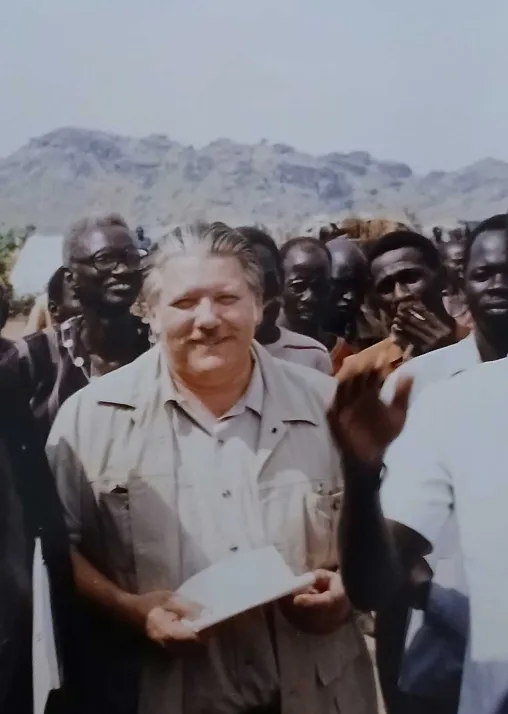
Former LWF Country director Robert Koepp during his time in Kenya. Photo: Robert Koepp/ private
Kakuma would never be the same again.
Robert KOEPP, former LWF Country Director in Kenya
The initial LWF team, led by John Parker, an LWF consultant, established the camp by coordinating incoming refugees, measuring plots, and setting up basic services. The team also benefited from Martin Taylor, an experienced water and sanitation consultant. The Turkana community, the local host population, gained employment and economic opportunities through construction projects. By the end of 1992, Kakuma was fully operational, providing shelter, education, water, and sanitation to thousands of refugees.
It is encouraging to know that after so many years, LWF has maintained its support, assisting tens of thousands of South Sudanese. Kakuma has since evolved into a city with shops, hotels, and an airport, continuing to play a vital role in addressing ongoing refugee movements in the region, including conflicts in what is now the Republic of South Sudan.
LWF Kenya-Somalia has been active in northwest Kenya in the Kakuma Refugee Camp since the camp was established in 1992. Today, LWF is the main implementing partner for education in Kakuma and Dadaab, managing primary and secondary schools for 97,000 children.
LWF’s work focuses on Education, Reception Centre Management, Protection and Social Cohesion, and Sustainable Livelihoods alongside climate change initiatives. The goal is to benefit the entire community by developing long-term solutions that encourage community involvement, build networks, and establish supportive structures.
The full story can be found in the LWF archives.
